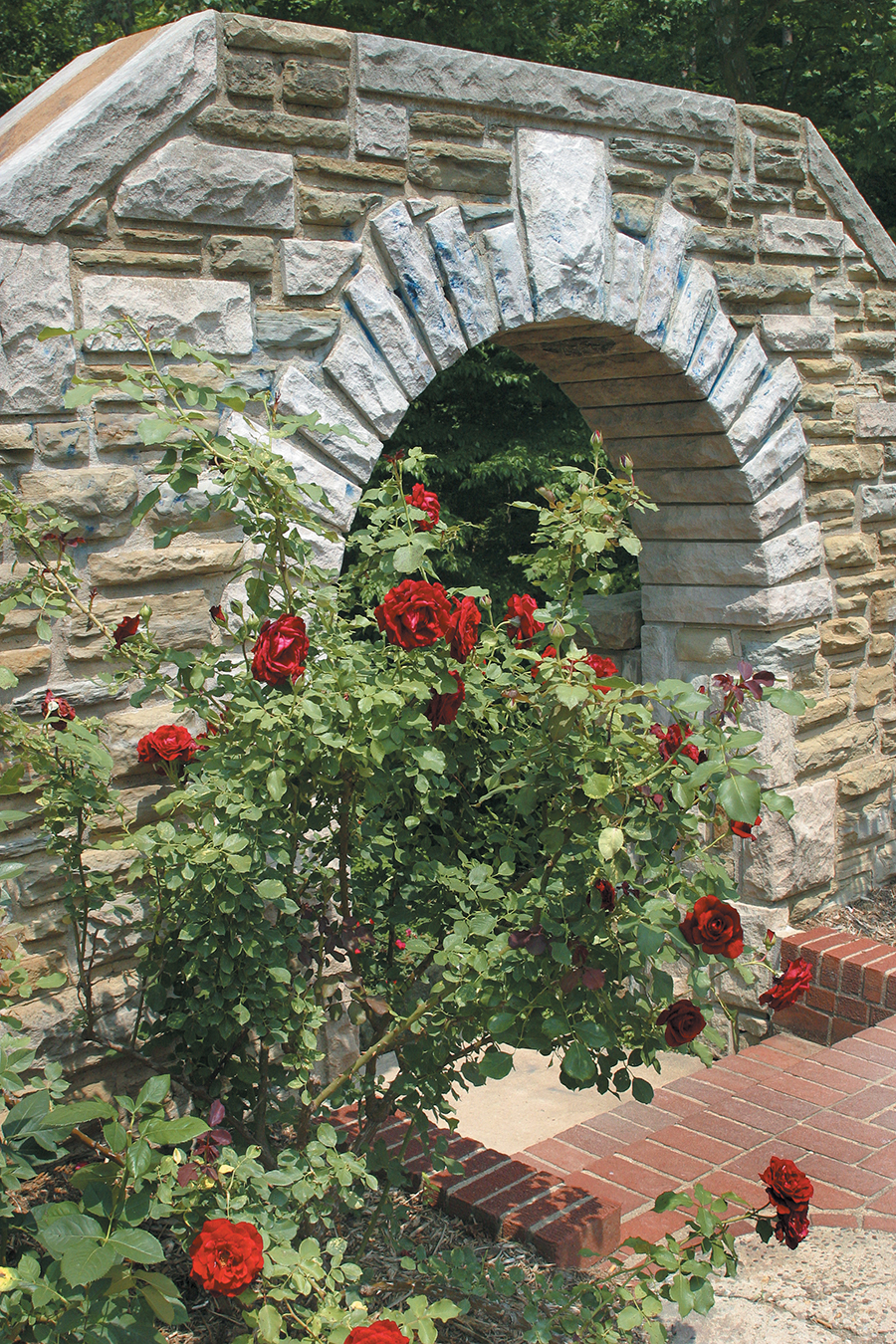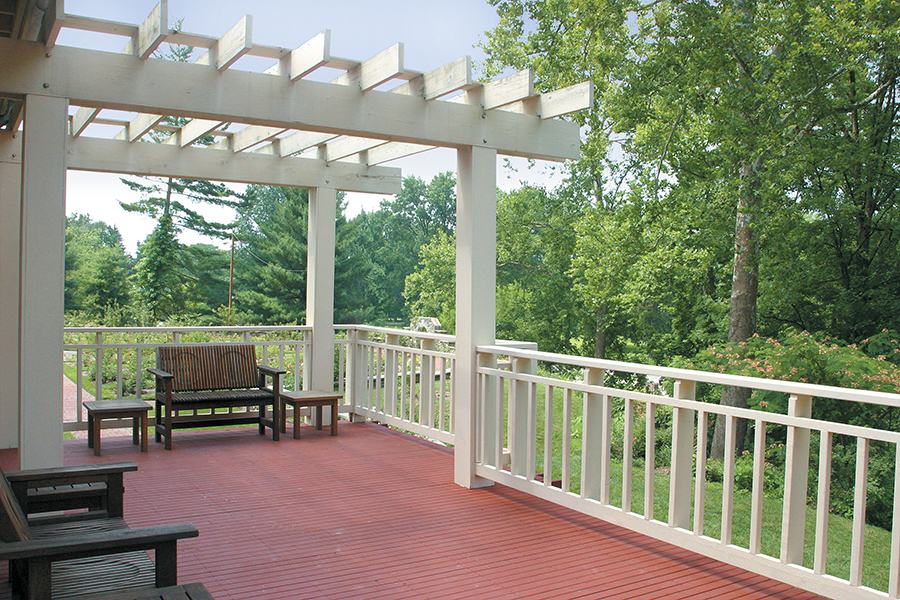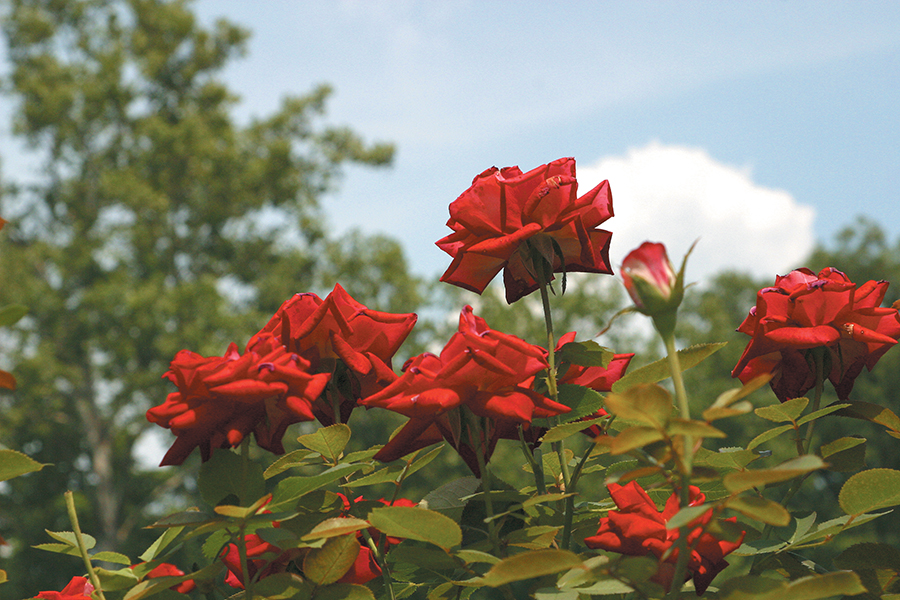By Lee R. Clarkson
HQ 52 | SUMMER 2004
My grandmother’s favorite rose was Chicago Peace – a hybrid tea rose with a yellow and pink blend. Mimi liked the subtler version, not the flashy Chicago Peace with a coppery canary yellow base and bright pink petals. She was as gentle and refined as any rose in her garden and would not choose a show-off as her favorite.
When I was a child, a variety of roses welcomed me into her home. She was certain to place a couple of roses in a small vase on the bedside table of the room where I stayed on weekends and summer visits. I always knew those roses would be there for me, my grandmother’s subtle greeting.
Years later, I miss that extra touch. At hotels and friends’ homes, I half expect to see a rose or two on the bedside table. Only now do I realize the amount of work and dedication that go into growing and caring for roses.
For any rose gardener, my discussion of red, pink, yellow and white roses might be offensive. I haven’t yet developed my grandmother’s green thumb, and I definitely do not know all the names of the roses. Tropicana, Sultry, Barbara Bush, Crimson Bouquet and Gold Medal all sound like strange names for roses, but rose lovers can cite the names and descriptions of roses in their own gardens. For me, the Ritter Park Rose Garden is a good place to start learning about roses.

Huntington’s park system began in 1908 under City Councilman Rufus Switzer. The City purchased 55 acres of land along Four Pole Creek stretching from Eighth to Twelfth Street south of Thirteenth Avenue. The land was intended for an incinerator, but when objections surfaced, Switzer made new plans for a city park. Charles Lloyd Ritter, a lumber manufacturer, bank director and businessman, donated an additional 20 acres. The 75 acres were then named Ritter Park.
In 1909, Switzer was elected mayor, and New Jersey landscape architect J.T. Withers prepared a plan for Ritter Park at Switzer’s request. This plan was not carried out under Switzer, who was defeated in his reelection, but the new administration employed local talent to draw up alternative plans used in the initial development of the park. After a number of changes in the plans, Ritter Park opened on Sept. 11, 1913. In 1925, the Huntington Board of Park Commissioners formed and took over the development of the city park system.
Gus C. Wofford, a member of the Park Commission and a landscape architect, created the design for the Ritter Park Rose Garden in the early 1930s and oversaw its construction. Annual levies provided the funding for its development. In 1936, the Rose Garden had its first rosarian, Jacob Eversdyke. A member of the American Rose Society described the garden in a 1939 article in The Herald-Advertiser: “The city of Huntington has a public rose garden, which for sheer beauty of design, fortunate location, unique features, beautiful roses and all round loveliness might be compared to a polished jewel in an appropriate setting. It may not be as large as many other municipal rose gardens, but it is an outstanding achievement.”

The garden has four levels connected by steps, bordered by stone walls and paths, and a decorative compass lies in the concrete at the entrance off McCoy Road. Recessed stone benches accent the edges of the compass and provide a place for visitors from both near and far to sit and enjoy the surrounding roses.
Ritter Park began to show its age in the 1970s, but renovations and additions helped improve the quality of the park. In 1989, Truman Watts was hired as part-time rosarian for the Rose Garden. His work resulted in a consistently beautiful garden with well-tended rose beds. In 1997, the Rose Garden was again enhanced with off-street parking, a gardener’s maintenance space and a 576 square foot visitors’ center.
The Ritter Park Rose Garden exhibits approximately 200 varieties of roses, 10 or so bushes each. The total number of bushes in the garden currently hovers around 2,000.
Each year, the garden, a member of the American Rose Society and an All-American Rose Selection garden, receives a new batch of roses to display and test before those roses are sold to individuals for use in their home gardens. Every year, new varieties are added to the collection. Ritter Park’s Rose Garden is one of a few test gardens in the U.S. It is also a favorite subject for photographers and provides an ideal setting for weddings in Huntington.

Every November, Watts acts as host to amateur and experienced gardeners alike who visit the Rose Garden to get slips for their own use. Watts cuts off pieces of the bushes and distributes them to people, first come, first served. This event allows local residents to recreate the beauty of the Rose Garden at their own homes.
My grandmother would approve. She loved to share the beauty of her roses. After 50 years of growing her own, Mimi had roses on her final bedside table, a dozen yellow ones she called “Perfectly Beautiful.”
|
Truman Watts: Caretaker of the Garden When Truman Watts first took the job of caretaker, or rosarian, he knew little about roses and their maintenance. He readily admits that he knew nothing about the terminology of roses or the multitude of tasks that must be accomplished in order to grow them. He began by talking to another rosarian and reading anything he could find about proper rose care. Applying pesticides, spraying, dead-heading, pruning, disbudding, fertilizing, watering, testing soil, winterizing and installing new beds and drain lines are on the list of tasks Watts has to complete in order to maintain the garden. Since 1989, Watts has been responsible for keeping the garden healthy and flourishing. Prior to becoming a rosarian, Watts worked in Cleveland, Ohio, in an automotive factory where he built motors. He also spent time working for the C & O Railway, constructing and repairing bridges, trestles and culverts. These industrial settings connote a harsh, metallic strength. How could a man who spent most of his life working in that environment make the transition into the delicate world of rose gardening? Watts says gardening is hard work. One has to scrounge around in the dirt, cutting leaves and picking up debris. A rosarian may be able to look at the blooms as something beautiful and fragile, but the work it takes to grow that garden is extensive. Now, Watts answers to the Greater Huntington Parks and Recreation District, an independent governing body of elected, unpaid representatives. When the garden requires particular attention, Watts makes requests to the Park Board. Nature dictates the needs of the garden, and Watts says he has to be flexible in order to get everything done. People seem to think that working as a rosarian is an easy job, but to watch Watts at work is to understand the time and effort is takes to create such results. He says he enjoys the work and does like meeting unique people from all over the country and the world. However, Watts says he would rather work on the roses than spend too much time talking to visitors. With 40 hours in a work week, it is hard to get everything done, so Watts tries to invite people into the garden and answer their questions without taking time away from the work at hand. The most frustrating challenge for Watts is to keep people from stealing the roses. Few visitors try to cut roses for themselves but those who do often become confrontational. Watts explains that when he catches someone cutting a rose, that person usually feigns ignorance or becomes defensive. One man actually demanded an apology of the rosarian after cutting a rose. As teachers or parents love all their children, so too does Watts love all the roses. “My favorites are the ones that are in bloom when I’m looking at them. Now that can be any of them.” But Watts admits a fondness for St. Patrick because it stands up well to the heat. St. Patrick is a slow-opening, pale yellow rose with a tint of green. He also likes Gemini, a cream-colored rose with coral pink edges, and Moonstone, a white and pink soft blend. Among the stand-outs in the garden are Perfect Moment, a dramatic rose with a yellow base and red petals, and Rio Samba, a hot yellow rose with orange edges. For more information about events at the Ritter Park Rose Garden, contact the Greater Huntington Parks and Recreation District at (304) 696-5954 or online at www.ghprd.org. |





